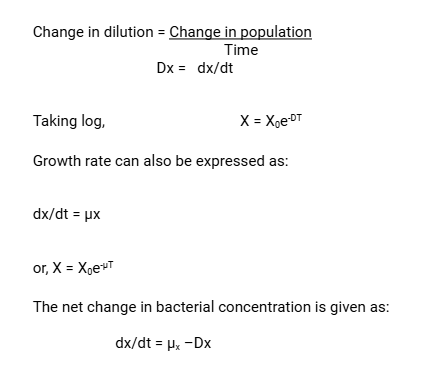Introduction to Bacterial Growth:
Cells divide when they have gathered everything they require for growth. The population doubles during the exponential phase of expansion, which is characterized by rapid increase under ideal circumstances.
During the exponential phase, every cell undergoes rapid, regular division through binary fission, leading to geometric (exponential) population expansion. The cells divide at a constant rate and if log of cell is plotted against the time, a straight line is obtained.
The growth rate is influenced by the genetic make of the organism which determines the shape of bacteria and the physiology which affect factors like nutrient acquisition.
The log phase is also the stage where bacteria are the most susceptible to the action of disinfectants and common antibiotics because they are in active growing phase.
The generation time (g), which represents the duration needed for a bacterial population to double in number, can be measured precisely during this phase of growth. By graphing the logarithmic values of cell count against time, one can accurately derive the doubling time of the bacteria.
Bacterial exponential growth kinetics:
Bacterial populations expand geometrically when they proliferate exponentially through binary fission. When a single cell splits, two cells are produced in the first generation and four in the second.
Because bacteria population divides every generation, if the initial population size is N0, after one generation,
N1 = N0 21
After two generations, N2 = N022
After n generations of growth,
N=N02n
This equation represents the consistent relationship between the initial cell count at the beginning of the exponential growth phase and the cell count after a given time interval. It reflects the process of binary fission, where N denotes the final cell concentration, N₀ is the initial concentration, and n indicates the number of generations that have taken place during that time.
logN= logN0 + nlog2
n = (logN – logN0 ) log2
n = (logN – logN0 )/0.301
Therefore, by knowing the initial cell density at the onset of exponential growth and the cell density after a defined time interval within this phase, one can determine the total number of generations that have occurred. In batch culture, the pace of microbial proliferation during the logarithmic phase can be quantitatively described using the mean growth rate constant.
K= n/t = (logN-logN0)/ 0.301t
The mean doubling time or mean generation time can be calculated. If the population doubles i.e. g=t
Then N=N0
Substituting 2N0 in mean growth rate equation and solving for K,
K= (Log (2N0) – Log N0 )/0.301
or, K= (Log2 + logN0 – logN)/0.301
or, K= 1/g
Generation time (g) is calculated by dividing the total time period (t) by the number of generations (n), where t can be measured in minutes, hours, days, or months. By knowing the duration of growth, the generation time can be determined.
The relation between growth rate substrate dilution rate during continuous culture:
Continuous culture is an open system which maintains constant volume to which fresh medium is added at a constant rate and equal volume of exhausted medium is removed at the same time. In continuous culture, microbial population can be maintained in log phase and constant biomass concentration can be maintained. Once such system is in equilibrium, continuous culture volume, cell number and nutrient status remain constant and system is said to be in steady state condition.
Achieving the steady state condition is crucial while conducting a continuous fermentation operation. The dilution rate, specific growth rate, and product yield on the substrate are the primary process parameters that can be utilized with the Chemostat technology.
All continuous flow systems consist essentially of some form of reactor into which reactants flow at a steady rate and from which products emerge.
A chemostat operates with a thoroughly mixed culture where fresh medium is continuously added at a constant rate, while an equal volume of culture is simultaneously removed, maintaining a constant culture volume. A stable equilibrium, or steady state, is established when fresh medium is continuously supplied at an appropriate rate, such that the production of new biomass by the microorganisms is matched by the removal of biomass from the system. This continuous flow of medium relative to the vessel’s volume is defined by the dilution rate (D), calculated as follows:
D = F/V
Where,
F is the flow rate (l/h) and
V is the volume
The biomass equation for the continuous reactor, which includes the term with the dilution rate, can be used to determine the net change in cell concentration over time:

A continuous culture may be operated at dilution rates below the maximum specific growth rate and so within certain limits, the dilution rate may be used to control the growth rate of the culture. Cell growth in such a continuous culture is controlled by the availability of the growth limiting substrate.
The mechanism underlying the controlling effect of the dilution rate is expressed in the Monod equation:
μ = μmax S / (Ks+ S)
Where,
μ = specific growth rate
μmax=maximal specific growth rate
S = Substrate concentration
Ks= Saturation constant defined as the substrate concentration at half μmax
Rearranging the equation, S = Ks
(μmax –D)
AT steady state, μ = D
S = KsD
(μmax –D)
This suggests that the dilution rate determines the substrate concentration. This happens when the cells’ proliferation depletes the substrate to a level that sustains a growth rate equivalent to the dilution rate.
